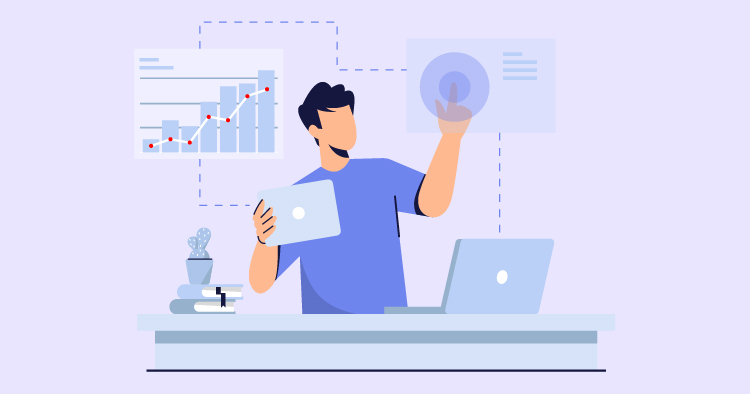Understanding and optimizing sales funnel conversion rates is crucial for any business looking to enhance its performance. A sales funnel represents the customer journey from the initial awareness stage to the final purchase. Analyzing conversion rates at each stage of this funnel can provide invaluable insights into customer behavior and pinpoint areas for improvement. By focusing on these metrics, businesses can fine-tune their marketing strategies, align their sales processes, and ultimately increase their overall conversion rates. This post will explore the importance of monitoring sales funnel conversion rates and how to leverage this analysis for business growth.
Understanding the Sales Funnel
A sales funnel is like a map showing customers’ journey from discovering your company to buying something. Think of it as a journey where each step or stage has its own goal. At the start, you have the “awareness” stage, where people first see or hear about your business. Then comes “interest,” where they start to think your product or service might be helpful for them.
After that, there’s the “decision” stage, where they seriously consider buying from you. Finally, there’s “action,” where they buy something. Each stage is a chance to connect with potential customers and help them move to the next step. For example, initially, you might use ads or social media to catch their eye. Later, you might offer more information or customer reviews to help them decide to buy.
The key is understanding what your customers need at each stage and how to meet those needs. This way, you can guide them smoothly from just knowing about your company to making a purchase.
Setting Clear Goals
Knowing your goal is essential when working with a sales funnel. Setting clear goals gives you something to aim for and helps you see if your sales funnel works well. Without these goals, you might not know if you’re on the right track or what to improve.
Your goals should be clear and achievable. Think about what’s typical for your industry, how you’ve done it in the past, and what resources you have. Your goals should push you a bit but still be achievable. And they should always help your business grow in the direction you want.
For example, you might set a goal to increase the number of people who move from the “interest” stage to the “decision” stage by 10% in the next three months. Or, you might aim to get more repeat customers by improving the buying experience. Whatever your goals, they should be specific, like these examples, so you can see how well your sales funnel is working and where you can make it even better.
Identifying Key Performance Indicators (KPIs)
Key Performance Indicators, or KPIs, are vital tools that help you understand how effectively your sales funnel works. They are like a report card for your funnel, showing you where you’re succeeding and where there’s room for improvement. By monitoring these KPIs, you can make intelligent choices to fine-tune your sales process and boost conversions.
Struggling with Digital marketing? Book Your Free Strategy Session!
- 30-Minutes Session
- Expert Insights
- Data-Driven approach
- Optimized Strategies for Your Goals
Some of the most important KPIs to track include the number of leads at each stage of your funnel, the number of those leads that turn into customers (that’s your conversion rate), the cost of acquiring a new customer (customer acquisition cost), and the value a customer brings over time (customer lifetime value). Monitoring these KPIs helps you pinpoint the stages where you might lose potential customers and highlights the strong points in your funnel.
Collecting and Analyzing Data
You must collect and analyze your data to understand your sales funnel’s performance. This information is like a window into your customers’ actions and thoughts, showing you what they like, what they don’t, and what might stop them from purchasing. When you understand your customers better, you can adjust your funnel to more closely meet their needs.
Analyzing your data means looking for patterns that can tell you a lot about how your funnel is doing. For instance, you can use tools like Google Analytics to see how many people visit your website and how many make a purchase. Breaking your data into smaller groups can help you understand your customers’ behaviors and preferences. These insights can be beneficial when making specific changes to improve your sales funnel.
Identifying Bottlenecks in the Sales Funnel
When looking at your sales funnel, you might find specific steps where potential customers get stuck or drop out. This could happen because the checkout process is too complex, the message about the product isn’t clear, or customers don’t feel confident in the security or reliability of the purchase.
To determine these bottlenecks, look closely at each part of your sales funnel and see where people leave. Getting customer feedback can also give you insight into what’s making it hard for them to move forward. Once you know where the problems are, you can fix them by making your processes more straightforward, your messages more transparent, and by showing that your business is trustworthy. This could mean adding customer reviews or ensuring your site has secure signs, like badges for safe payments.
Optimizing Landing Pages
Landing pages are important because they’re often the first real interaction someone has with your offering. If you get your landing page right, you can get many more people to take the next step, whether buying something, signing up for a newsletter, or another action.
To make your landing page work well, start with a headline that grabs attention and clarifies your offering. Keep your message short and to the point, and make sure your call to action stands out and tells visitors exactly what to do next. The design should be easy to navigate, and the page should load fast, especially on mobile devices, as many people browse the internet on their phones.
You can also use A/B testing when you try out different versions of things like your call-to-action buttons or the pictures you use to see which one people respond to better. This helps you fine-tune your landing page for even better results.
Create Compelling Call-to-Actions (CTAs)
Call-to-Actions, or CTAs, are signposts that guide your visitors on what to do next. Without them, people might wander on your site without taking meaningful action. But with a strong CTA, you can turn those visitors into leads or even paying customers.
Struggling with Digital marketing? Book Your Free Strategy Session!
- 30-Minutes Session
- Expert Insights
- Data-Driven approach
- Optimized Strategies for Your Goals
To craft a CTA that works, use words that spur people into action. Think about what you want them to do and use verbs like ‘Get,’ ‘Learn,’ or ‘Buy.’ Make sure your CTA stands out visually—use colors and fonts that grab attention. And always make sure the CTA is relevant to where the visitor is in their journey with you. For instance, if they’re learning about your product, ‘Learn More’ might work better than ‘Buy Now.’
It’s also wise to try different CTAs to see which resonates with your audience. Maybe placing a ‘Sign Up’ button at the top of the page works better than at the bottom, or perhaps a ‘Free Trial’ offer gets more clicks than a ‘Schedule a Demo.’ Test, learn, and adapt.
Streamlining the Checkout Process
A smooth checkout process is critical when making a purchase. You don’t want your customers to give up because they got lost in a maze of forms and steps. Too many complications at this stage can lead to an abandoned cart, a missed opportunity.
To make the checkout process as smooth as silk, reduce the steps needed to buy something. Keep the design clean and the instructions crystal clear. People also like to feel secure when handing over their payment information, so show them trusted security badges and positive reviews from other customers.
It’s also a good idea to provide a variety of payment options. People have their preferences and conveniences, so the more choices you offer, the better. Plus, if you can remember your customers’ details for next time (with their permission, of course), you’ll make their future purchases quicker and more accessible, encouraging them to return.
Leveraging Social Proof
Social proof is like a magnet that draws people in. When potential customers see that others have had positive experiences with your product or service, they’re more likely to follow suit. Think of it as the digital version of word-of-mouth. People often look to others when deciding what to buy, and seeing happy customers can tip the scales in your favor.
You can showcase social proof in several ways throughout your sales funnel. Customer testimonials, user reviews, and expert endorsements are gold for your business. When people visit your website and see these positive signals, their trust in your brand can grow. Social media is another great stage for social proof. Sharing user-generated content, like photos of customers using your product, can make your brand feel more relatable and trustworthy.
Implementing A/B Testing
Imagine peering into the future to see which version of your website or ad gets you more sales. That’s what A/B testing lets you do, but in the present. It’s comparing two webpage versions or an email to see which people respond better. By doing this, you take the guesswork out of making your sales funnel more effective.
Here’s how to do it right: Pick just one thing to change, like the wording of a call to action or a picture. Then, show these different versions to similar groups of people. You’ll need enough people to make your results meaningful, and tools like Google Analytics can help you see which version is the winner. Once you know what works best, you can hopefully use that version to get more customers.
Personalizing the Customer Journey
Making the shopping experience personal can make a big difference in winning customers. When you understand what each customer likes and how they shop, you can make their experience feel special. This can lead to more sales because customers enjoy a service created just for them.
To make each customer’s journey feel personal, learn about them. Collect information on what they like and what they do when they shop. Then, you can group your customers based on their interests and shopping habits. Once done, you can create messages and offers that speak directly to them. Personal touches can be simple, like using a customer’s name in an email, or more detailed, like suggesting products they might like based on what they’ve bought before or what they’ve looked at on your site.
Nurturing Leads for Higher Conversions
Building a relationship with potential customers is critical to turning them into actual customers. This process, called lead nurturing, involves staying connected and being helpful at every step when considering purchasing.
To nurture leads effectively, keep in touch with them through emails that feel personal, share content that they’ll find helpful, and make offers that are right for where they are in the decision-making process. Automation tools can help you send out these messages at the right time. It’s also important to share information that solves problems they might have or answers questions they’re thinking about. By doing this, you’re guiding them gently towards deciding to buy from you.
Using Remarketing Campaigns
Remarketing campaigns are a fantastic way to boost the number of people who move through your sales funnel and make a purchase. These campaigns specifically target people who have already shown interest in your products or services by visiting your website but left without buying anything. By reminding them of what they’ve seen, you can keep your brand in their thoughts, often leading to them returning to complete a purchase.
It’s essential to divide your audience into groups based on their interaction with your website to get the most out of your remarketing efforts. This allows you to create personalized ads that speak directly to their interests or address any concerns that might have stopped them from buying the first time around. You can use tools from platforms such as Google Ads and Facebook to reach these audiences again with tailored messaging that resonates with them.
Analyzing and Optimizing Conversion Rates
Keeping a close eye on how well your sales funnel works and making continual improvements is crucial for success. By regularly checking on the effectiveness of your funnel, you can pinpoint where you might be losing potential customers and tweak your approach to fix those issues.
Tools like Google Analytics can be invaluable in understanding what’s going on with your conversion rates. They let you see how users interact with your site and track important metrics that tell you how well you convert visitors into buyers. Make it a routine to review these metrics and try out different versions of your funnel elements with A/B testing to see what works best. Also, staying in the loop with the latest sales funnel strategies and trends is essential to keep your approach fresh and competitive.
Final Thoughts
Businesses aiming to thrive in a competitive market cannot overstate the significance of analyzing sales funnel conversion rates. A deep dive into these metrics reveals the health of your sales process and identifies opportunities to enhance customer engagement and retention. Implementing targeted strategies based on this analysis can lead to a more efficient sales funnel and higher profitability. As we’ve discussed, continuous improvement and adaptation are crucial to maintaining an edge and ensuring your business attracts and retains customers effectively.



